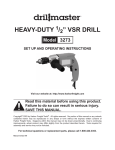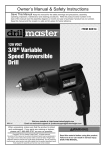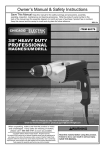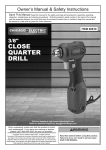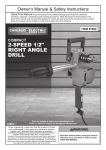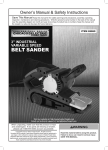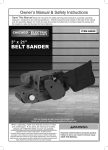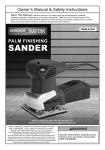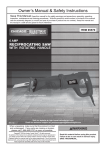Download Harbor Freight Tools 1/2 In Variable Speed Reversible Hammer Drill Product manual
Transcript
Table of contents SAFETy Safety .................................................2 Specifications .....................................8 Setup ..................................................8 Operation ...........................................10 Maintenance ......................................12 Parts List and Diagram ......................14 Warranty ............................................16 WARNING SyMBOLS AND DEFINITIONS This is the safety alert symbol. It is used to alert you to potential personal injury hazards. Obey all safety messages that follow this symbol to avoid possible injury or death. SETUp Indicates a hazardous situation which, if not avoided, will result in death or serious injury. Indicates a hazardous situation which, if not avoided, could result in death or serious injury. Indicates a hazardous situation which, if not avoided, could result in minor or moderate injury. Addresses practices not related to personal injury. OpERATION IMpORTANT SAFETy INFORMATION General power Tool Safety Warnings Read all safety warnings and instructions. Failure to follow the warnings and instructions may result in electric shock, fire and/or serious injury. Save all warnings and instructions for future reference. The term ″power tool″ in the warnings refers to your mains-operated (corded) power tool. MAINTENANcE Work area safety 1. Keep work area clean and well lit. Cluttered or dark areas invite accidents. 2. Do not operate power tools in explosive atmospheres, such as in the presence of flammable liquids, gases or dust. Power tools create sparks which may ignite the dust or fumes. Page 2 3. Keep children and bystanders away while operating a power tool. Distractions can cause you to lose control. For technical questions, please call 1-800-444-3353. Item 69947 4. Do not abuse the cord. Never use the cord for carrying, pulling or unplugging the power tool. Keep cord away from heat, oil, sharp edges or moving parts. Damaged or entangled cords increase the risk of electric shock. 2. Avoid body contact with grounded surfaces such as pipes, radiators, ranges and refrigerators. There is an increased risk of electric shock if your body is grounded. 5. When operating a power tool outdoors, use an extension cord suitable for outdoor use. Use of a cord suitable for outdoor use reduces the risk of electric shock. 3. Do not expose power tools to rain or wet conditions. Water entering a power tool will increase the risk of electric shock. 6. If operating a power tool in a damp location is unavoidable, use a Ground Fault circuit Interrupter (GFcI) protected supply. Use of a GFCI reduces the risk of electric shock. personal safety 3. prevent unintentional starting. Ensure the switch is in the off-position before connecting to power source, picking up or carrying the tool. Carrying power tools with your finger on the switch or energizing power tools that have the switch on invites accidents. 4. Remove any adjusting key or wrench before turning the power tool on. A wrench or a key left attached to a rotating part of the power tool may result in personal injury. Item 69947 6. Dress properly. Do not wear loose clothing or jewelry. Keep your hair, clothing and gloves away from moving parts. Loose clothes, jewelry or long hair can be caught in moving parts. 7. If devices are provided for the connection of dust extraction and collection facilities, ensure these are connected and properly used. Use of these devices can reduce dust-related hazards. 8. Only use safety equipment that has been approved by an appropriate standards agency. Unapproved safety equipment may not provide adequate protection. Eye protection must be ANSI-approved and breathing protection must be NIOSH-approved for the specific hazards in the work area. For technical questions, please call 1-800-444-3353. Page 3 OpERATION 2. Use personal protective equipment. Always wear eye protection. Safety equipment such as dust mask, non-skid safety shoes, hard hat, or hearing protection used for appropriate conditions will reduce personal injuries. 5. Do not overreach. Keep proper footing and balance at all times. This enables better control of the power tool in unexpected situations. MAINTENANcE 1. Stay alert, watch what you are doing and use common sense when operating a power tool. Do not use a power tool while you are tired or under the influence of drugs, alcohol or medication. A moment of inattention while operating power tools may result in serious personal injury. SETUp 1. power tool plugs must match the outlet. Never modify the plug in any way. Do not use any adapter plugs with grounded power tools. Unmodified plugs and matching outlets will reduce risk of electric shock. SAFETy Electrical safety power tool use and care SAFETy SETUp 5. Maintain power tools. check for 1. Do not force the power tool. Use the misalignment or binding of moving correct power tool for your application. parts, breakage of parts and any other The correct power tool will do the job better and safer at the rate for which it was designed. condition that may affect the power tool’s operation. If damaged, have the power 2. Do not use the power tool if the tool repaired before use. Many accidents switch does not turn it on and off. are caused by poorly maintained power tools. Any power tool that cannot be controlled with the switch is dangerous and must be repaired. 6. Keep cutting tools sharp and clean. Properly maintained cutting tools with 3. Disconnect the plug from the power source sharp cutting edges are less likely to before making any adjustments, changing bind and are easier to control. accessories, or storing power tools. 7. Use the power tool, accessories and Such preventive safety measures reduce the tool bits etc. in accordance with these risk of starting the power tool accidentally. instructions, taking into account the 4. Store idle power tools out of the working conditions and the work to reach of children and do not allow be performed. Use of the power tool for persons unfamiliar with the power tool operations different from those intended or these instructions to operate the could result in a hazardous situation. power tool. Power tools are dangerous in the hands of untrained users. Service Have your power tool serviced by a qualified repair person using only identical replacement parts. This will ensure that the safety of the power tool is maintained. OpERATION Drill and Impact Drill Safety Warnings 1. Wear ear protectors with impact drills. Exposure to noise can cause hearing loss. 2. Use auxiliary handles supplied with the tool. Loss of control can cause personal injury. 3. Hold power tools by insulated gripping surfaces when performing an operation where the cutting tool may contact hidden wiring or its own cord. Contact with a ″live″ wire will make exposed metal parts of the tool ″live″ and shock the operator. MAINTENANcE 4. Let bit cool before touching, changing or adjusting it. Bits heat up dramatically while in use, and can burn you. 5. If the drill bit jams, release the trigger immediately; drill torque can cause injury or break bit. 6. Maintain labels and nameplates on the tool. These carry important safety information. If unreadable or missing, contact Harbor Freight Tools for a replacement. 7. Avoid unintentional starting. Prepare to begin work before turning on the tool. 8. Do not lay the tool down until it has come to a complete stop. Moving parts can grab the surface and pull the tool out of your control. 9. When using a handheld power tool, maintain a firm grip on the tool with both hands to resist starting torque. 10. Do not leave the tool unattended when it is plugged into an electrical outlet. Turn off the tool, and unplug it from its electrical outlet before leaving. 11. This product is not a toy. Keep it out of reach of children. Page 4 For technical questions, please call 1-800-444-3353. Item 69947 13. WARNING: Some dust created by power sanding, sawing, grinding, drilling, and other construction activities, contains chemicals known [to the State of California] to cause cancer, birth defects or other reproductive harm. Some examples of these chemicals are: • Lead from lead-based paints • Crystalline silica from bricks and cement or other masonry products • Arsenic and chromium from SAFETy chemically treated lumber Your risk from these exposures varies, depending on how often you do this type of work. To reduce your exposure to these chemicals: work in a well ventilated area, and work with approved safety equipment, such as those dust masks that are specially designed to filter out microscopic particles. (California Health & Safety Code § 25249.5, et seq.) 14. WARNING: Handling the cord on this product will expose you to lead, a chemical known to the State of California to cause cancer, and birth defects or other reproductive harm. Wash hands after handling. (California Health & Safety Code § 25249.5, et seq.) 15. The warnings, precautions, and instructions discussed in this instruction manual cannot cover all possible conditions and situations that may occur. It must be understood by the operator that common sense and caution are factors which cannot be built into this product, but must be supplied by the operator. SETUp 12. People with pacemakers should consult their physician(s) before use. Electromagnetic fields in close proximity to heart pacemaker could cause pacemaker interference or pacemaker failure. In addition, people with pacemakers should: • Avoid operating alone. • Do not use with power switch locked on. • Properly maintain and inspect to avoid electrical shock. • Properly ground power cord. Ground Fault Circuit Interrupter (GFCI) should also be implemented – it prevents sustained electrical shock. 1. Anyone using vibrating tools regularly or for an extended period should first be examined by a doctor and then have regular medical check-ups to ensure medical problems are not being caused or worsened from use. Pregnant women or people who have impaired blood circulation to the hand, past hand injuries, nervous system disorders, diabetes, or Raynaud’s Disease should not use this tool. If you feel any symptoms related to vibration (such as tingling, numbness, and white or blue fingers), seek medical advice as soon as possible. 2. Do not smoke during use. Nicotine reduces the blood supply to the hands and fingers, increasing the risk of vibration-related injury. 3. Wear suitable gloves to reduce the vibration effects on the user. 4. Use tools with the lowest vibration when there is a choice. 5. Include vibration-free periods each day of work. 6. Grip tool as lightly as possible (while still keeping safe control of it). Let the tool do the work. 7. To reduce vibration, maintain the tool as explained in this manual. If any abnormal vibration occurs, stop use immediately. SAVE THESE INSTRUcTIONS. Item 69947 For technical questions, please call 1-800-444-3353. Page 5 MAINTENANcE This tool vibrates during use. Repeated or long-term exposure to vibration may cause temporary or permanent physical injury, particularly to the hands, arms and shoulders. To reduce the risk of vibration-related injury: OpERATION Vibration Safety Grounding SAFETy TO pREVENT ELEcTRIc SHOcK AND DEATH FROM INcORREcT GROUNDING WIRE cONNEcTION: check with a qualified electrician if you are in doubt as to whether the outlet is properly grounded. Do not modify the power cord plug provided with the tool. Never remove the grounding prong from the plug. Do not use the tool if the power cord or plug is damaged. If damaged, have it repaired by a service facility before use. If the plug will not fit the outlet, have a proper outlet installed by a qualified electrician. SETUp Grounded Tools: Tools with Three prong plugs 2. The grounding prong in the plug is connected through the green wire inside the cord to the grounding system in the tool. The green wire in the cord must be the only wire connected to the tool’s grounding system and must never be attached to an electrically “live” terminal. (See Figure A.) Figure A: 3-prong plug and Outlet OpERATION 1. Tools marked with “Grounding Required” have a three wire cord and three prong grounding plug. The plug must be connected to a properly grounded outlet. If the tool should electrically malfunction or break down, grounding provides a low resistance path to carry electricity away from the user, reducing the risk of electric shock. (See Figure A.) 3. The tool must be plugged into an appropriate outlet, properly installed and grounded in accordance with all codes and ordinances. The plug and outlet should look like those in the preceding illustration. (See Figure A.) Double Insulated Tools: Tools with Two prong plugs MAINTENANcE 1. Tools marked “Double Insulated” do not require grounding. They have a special double insulation system which satisfies OSHA requirements and complies with the applicable standards of Underwriters Laboratories, Inc., the Canadian Standard Association, and the National Electrical Code. Figure B: Outlets for 2-prong plug Page 6 2. Double insulated tools may be used in either of the 120 volt outlets shown in the preceding illustration. (See Figure B.) For technical questions, please call 1-800-444-3353. Item 69947 Extension cords 5. If you are using one extension cord for more than one tool, add the nameplate amperes and use the sum to determine the required minimum cord size. (See Table A.) SAFETy 0 – 2.0 18 18 18 18 16 2.1 – 3.4 18 18 18 16 14 3.5 – 5.0 18 18 16 14 12 5.1 – 7.0 18 16 14 12 12 7.1 – 12.0 18 14 12 10 12.1 – 16.0 14 12 10 16.1 – 20.0 12 10 * Based on limiting the line voltage drop to five volts at 150% of the rated amperes. Symbology Canadian Standards Association Item 69947 n0 xxxx/min. No Load Revolutions per Minute (RPM) WARNING marking concerning Risk of Eye Injury. Wear ANSI-approved safety goggles with side shields. Underwriters Laboratories, Inc. Read the manual before set-up and/or use. Volts Alternating Current WARNING marking concerning Risk of Fire. Do not cover ventilation ducts. WARNING marking concerning Risk of Electric Shock. Maintain Power cord properly. Amperes For technical questions, please call 1-800-444-3353. MAINTENANcE Double Insulated V~ A SETUp 150´ (at full load) EXTENSION cORD LENGTH OpERATION 6. If you are using an extension cord outdoors, make sure it is marked with the suffix “W-A” (“W” in Canada) to indicate it is acceptable for outdoor use. NAMEpLATE AMpERES 100´ 4. When using more than one extension cord to make up the total length, make sure each cord contains at least the minimum wire size required. (See Table A.) Table A: Recommended Minimum Wire Gauge for Extension cords* (120/240 Volt) 75´ 3. The smaller the gauge number of the wire, the greater the capacity of the cord. For example, a 14 gauge cord can carry a higher current than a 16 gauge cord. (See Table A.) 8. Protect the extension cords from sharp objects, excessive heat, and damp or wet areas. 50´ 2. As the distance from the supply outlet increases, you must use a heavier gauge extension cord. Using extension cords with inadequately sized wire causes a serious drop in voltage, resulting in loss of power and possible tool damage. (See Table A.) 7. Make sure the extension cord is properly wired and in good electrical condition. Always replace a damaged extension cord or have it repaired by a qualified electrician before using it. 25´ 1. Grounded tools require a three wire extension cord. Double Insulated tools can use either a two or three wire extension cord. Page 7 Specifications SAFETy Electrical Rating 120V~ / 60Hz / 4.2A No Load Speed 2572 RPM Chuck Capacity 1/16″ - 1/2″ 4001254 Setup - Before Use: SETUp Read the ENTIRE IMpORTANT SAFETy INFORMATION section at the beginning of this manual including all text under subheadings therein before set up or use of this product. TO pREVENT SERIOUS INJURy FROM AccIDENTAL OpERATION: Turn the power Switch of the tool off and unplug the tool from its electrical outlet before assembling or making any adjustments to the tool. Note: For additional information regarding the parts listed in the following pages, refer to Parts List and Diagram on page 14. OpERATION Assembly 1. Loosen the grip on the Side Handle (33) and slide Side Handle clamp over and behind the Chuck (2) until it is set against housing. 4. To install the Depth Gauge (32), loosen the Side Handle and slide the Depth Gauge into the gauge hole. 2. Rotate the Side Handle until it is in desired orientation. 5. Set Depth Gauge to required depth and retighten grip to fasten Depth Gauge into place. 3. Rotate Side Handle grip clockwise to secure it. (See further Depth Gauge explanation under General Operating Instructions.) Figure c: Functions MAINTENANcE Page 8 For technical questions, please call 1-800-444-3353. Item 69947 Side Handle (33) SAFETy Function Switch (10) Depth Gauge (32) chuck (2) SETUp Lock Button Direction Switch Trigger (28) MAINTENANcE OpERATION chuck Key (34) Item 69947 For technical questions, please call 1-800-444-3353. Page 9 Operating Instructions SAFETy Read the ENTIRE IMpORTANT SAFETy INFORMATION section at the beginning of this manual including all text under subheadings therein before set up or use of this product. Tool Set Up TO pREVENT SERIOUS INJURy FROM AccIDENTAL OpERATION: Turn the power Switch of the tool off and unplug the tool from its electrical outlet before adjusting tool or installing accessories. Drill Bit Installation SETUp cAUTION! Wear heavy-duty work gloves to provide protection when inserting and removing drill bits. Drill bits become very hot during use. Do not remove drill bits until the bit has cooled. 4. Insert the tip of the Chuck Key into a hole on the side of the Chuck so that the teeth on the Key engage the gear on the Chuck. Use the Key to tighten the Chuck securely and remove the Key. 1. Loosen the Chuck with the Chuck Key until the jaws of the drill are opened enough to fit the drill bit. 5. Set the Function Switch to the appropriate setting for the drill bit, see Figure C on page 8. OpERATION 2. Place the desired drill bit or screwdriver bit into the drill between the Chuck Jaws. Set to Hammer Drill for masonry bits. Note: In addition to single or double-ended screwdriver bits, adapters with hexagonal shafts with matching socket heads can also be used. Set to Drill for other bits. 3. Hand tighten the Chuck until the bit is held securely in place, centered between the Chuck Jaws. NOTIcE: Use sharp bits. Dull, bent, or damaged bits will cause stress on the drill and/or break. Workpiece and Work Area Set Up 1. Designate a work area that is clean and well-lit. The work area must not allow access by children or pets to prevent distraction and injury. MAINTENANcE 2. Route the power cord along a safe route to reach the work area without creating a tripping hazard or exposing the power cord to possible damage. The power cord must reach the work area with enough extra length to allow free movement while working. Page 10 3. Secure loose workpieces using a vise or clamps (not included) to prevent movement while working. 4. There must not be objects, such as utility lines, nearby that will present a hazard while working. For technical questions, please call 1-800-444-3353. Item 69947 General Operating Instructions a. For clockwise (forward) rotation, push it from the right side. b. For counterclockwise (reverse) rotation, push it from the left side. NOTIcE: Do not change rotation direction while the Chuck is rotating. 3. Verify bit is securely locked in Chuck. 4. For continuous drilling, press Trigger, then Trigger Lock Button on side of handle, and release Trigger. To release lock, momentarily press Trigger. 5. Use the Depth Gauge for controlled depth drilling. Markings are not precise values, only general guides. To set gauge: a. Insert bit and tighten Chuck. SAFETy 2. Set Direction Switch to correct position. cAUTION! Use both hands during use. b. Loosen Side Handle, place tip of bit against solid surface and extend Depth Gauge until it is against same surface. c. Determine required hole-depth and retract Gauge accordingly. d. Tighten Side Handle. 6. To prevent accidents, turn off the tool and unplug it after use. Clean, then store the tool indoors out of children’s reach. SETUp 1. Make sure that the Switch/Trigger is in the off-position, then plug in the tool. Metal Drilling Tips 2. Start by drilling slowly to keep bit from wandering/skating away from your starting point. 3. When drilling large holes in metal, start by drilling a smaller pilot hole, then using a larger bit for the final size hole. Wood Drilling Tips 1. Use bits specially designed for wood drilling, such as brad point, spade bits, forstner bits, etc. 3. To prevent or reduce “break out” when bit penetrates work piece, clamp a piece of scrap material to back of work piece. 2. Start by drilling slowly to keep bit from wandering away from starting point. Increase speed as hole is established. OpERATION 1. Use a center punch (not included) to create a dimple for the bit to start. Masonry Drilling Operation 2. Set the Function by adjusting the Function Switch to the desired setting. 3. Plug in the Power Cord. 4. Squeeze and hold the Trigger to turn on the Rotary Hammer. 5. Do not apply excessive force, allow the tool to do the work. Item 69947 concrete Drilling Tips: a. Do not add water to the drill hole. b. Clean the bit flutes regularly while drilling. c. Back the bit out of the hole often during drilling, especially when drilling deep holes. d. Use the shortest bit practical. e. When drilling deep holes, work in stages, use a short bit for the beginning of the hole, then change to a longer bit. For technical questions, please call 1-800-444-3353. Page 11 MAINTENANcE 1. Adjust the Side Handle as needed. Maintenance and Servicing SAFETy procedures not specifically explained in this manual must be performed only by a qualified technician. TO pREVENT SERIOUS INJURy FROM AccIDENTAL OpERATION: Turn the power Switch of the tool off and unplug the tool from its electrical outlet before performing any inspection, maintenance, or cleaning procedures. TO pREVENT SERIOUS INJURy FROM TOOL FAILURE: Do not use damaged equipment. If abnormal noise or vibration occurs, have the problem corrected before further use. cleaning, Maintenance, and Lubrication SETUp 1. BEFORE EAcH USE, inspect the general condition of the tool. Check for: • loose hardware, • misalignment or binding of moving parts, • cracked or broken parts, 2. AFTER USE, wipe external surfaces of the tool with clean cloth. 3. WARNING! If the supply cord of this power tool is damaged, it must be replaced only by a qualified service technician. • damaged electrical wiring, and • any other condition that may affect its safe operation. OpERATION MAINTENANcE Page 12 For technical questions, please call 1-800-444-3353. Item 69947 Troubleshooting 2. No power at outlet. 2. Check power at outlet. If outlet is unpowered, turn off tool and check circuit breaker. If breaker is tripped, make sure circuit is right capacity for tool and circuit has no other loads. 3. Tool’s thermal reset breaker tripped (if equipped). 3. Turn off tool and allow to cool. Press reset button on tool. 4. Internal damage or wear. 4. Have technician service tool. (Carbon brushes or switch, for example.) 1. Allow tool to work at its own rate. 1. Forcing tool to work too fast. 2. Extension cord too long or cord diameter too small. Performance decreases over time. Excessive noise or rattling. Overheating. 1. Carbon brushes worn or damaged. 2. Eliminate use of extension cord. If an extension cord is needed, use one with the proper diameter for its length and load. See Extension Cords in Grounding section on page 6. 1. Have qualified technician replace brushes. 2. Bit dull or damaged. Internal damage or wear. (Carbon brushes or bearings, for example.) 1. Forcing tool to work too fast. 2. Keep bits sharp. Replace as needed. Have technician service tool. 2. Bit dull or damaged. 2. Keep bits sharp. Replace as needed. 3. Blocked motor housing vents. 3. Wear ANSI-approved safety goggles and NIOSH-approved dust mask/respirator while blowing dust out of motor using compressed air. 4. Motor being strained by long or small diameter extension cord. 4. Eliminate use of extension cord. If an extension cord is needed, use one with the proper diameter for its length and load. See Extension Cords in Grounding section on page 6. 1. Allow tool to work at its own rate. Item 69947 For technical questions, please call 1-800-444-3353. MAINTENANcE Follow all safety precautions whenever diagnosing or servicing the tool. Disconnect power supply before service. SETUp Tool operates slowly. Likely Solutions 1. Check that cord is plugged in. SAFETy possible causes OpERATION problem Tool will not start. 1. Cord not connected. Page 13 parts List and Diagram SAFETy pLEASE READ THE FOLLOWING cAREFULLy THE MANUFACTURER AND/OR DISTRIBUTOR HAS PROVIDED THE PARTS LIST AND ASSEMBLY DIAGRAM IN THIS MANUAL AS A REFERENCE TOOL ONLY. NEITHER THE MANUFACTURER OR DISTRIBUTOR MAKES ANY REPRESENTATION OR WARRANTY OF ANY KIND TO THE BUYER THAT HE OR SHE IS QUALIFIED TO MAKE ANY REPAIRS TO THE PRODUCT, OR THAT HE OR SHE IS QUALIFIED TO REPLACE ANY PARTS OF THE PRODUCT. IN FACT, THE MANUFACTURER AND/OR DISTRIBUTOR EXPRESSLY STATES THAT ALL REPAIRS AND PARTS REPLACEMENTS SHOULD BE UNDERTAKEN BY CERTIFIED AND LICENSED TECHNICIANS, AND NOT BY THE BUYER. THE BUYER ASSUMES ALL RISK AND LIABILITY ARISING OUT OF HIS OR HER REPAIRS TO THE ORIGINAL PRODUCT OR REPLACEMENT PARTS THERETO, OR ARISING OUT OF HIS OR HER INSTALLATION OF REPLACEMENT PARTS THERETO. SETUp parts List part OpERATION 1 2 3 4 5 6 7 8 9 10 11 12 Description Screw Chuck Spindle Ball Spring Needle Bearing Retaining Ring Gear Arm Function Switch Gearbox Ball Bearing (608) part 13 14 15 16 17 18 19 20 21 22 23 24 Description Brush Holder Carbon Brush Brush Cap Right Housing Screw Inductor Ball Retaining Ring Needle Bearing Rotor Ball Bearing (626) Stator part 25 26 27 28 29 30 31 32 33 34 Description Left Housing Cord Clip Screw Trigger Capacitor Cord Protector Cord Depth Gauge Side Handle Chuck Key Record product’s Serial Number Here: Note: If product has no serial number, record month and year of purchase instead. Note: Some parts are listed and shown for illustration purposes only, and are not available individually as replacement parts. MAINTENANcE Page 14 For technical questions, please call 1-800-444-3353. Item 69947 MAINTENANcE OpERATION SETUp SAFETy Assembly Diagram Item 69947 For technical questions, please call 1-800-444-3353. Page 15 Limited 90 Day Warranty Harbor Freight Tools Co. makes every effort to assure that its products meet high quality and durability standards, and warrants to the original purchaser that this product is free from defects in materials and workmanship for the period of 90 days from the date of purchase. This warranty does not apply to damage due directly or indirectly, to misuse, abuse, negligence or accidents, repairs or alterations outside our facilities, criminal activity, improper installation, normal wear and tear, or to lack of maintenance. We shall in no event be liable for death, injuries to persons or property, or for incidental, contingent, special or consequential damages arising from the use of our product. Some states do not allow the exclusion or limitation of incidental or consequential damages, so the above limitation of exclusion may not apply to you. THIS WARRANTY IS EXPRESSLY IN LIEU OF ALL OTHER WARRANTIES, EXPRESS OR IMPLIED, INCLUDING THE WARRANTIES OF MERCHANTABILITY AND FITNESS. To take advantage of this warranty, the product or part must be returned to us with transportation charges prepaid. Proof of purchase date and an explanation of the complaint must accompany the merchandise. If our inspection verifies the defect, we will either repair or replace the product at our election or we may elect to refund the purchase price if we cannot readily and quickly provide you with a replacement. We will return repaired products at our expense, but if we determine there is no defect, or that the defect resulted from causes not within the scope of our warranty, then you must bear the cost of returning the product. This warranty gives you specific legal rights and you may also have other rights which vary from state to state. 3491 Mission Oaks Blvd. • PO Box 6009 • Camarillo, CA 93011 • (800) 444-3353
















